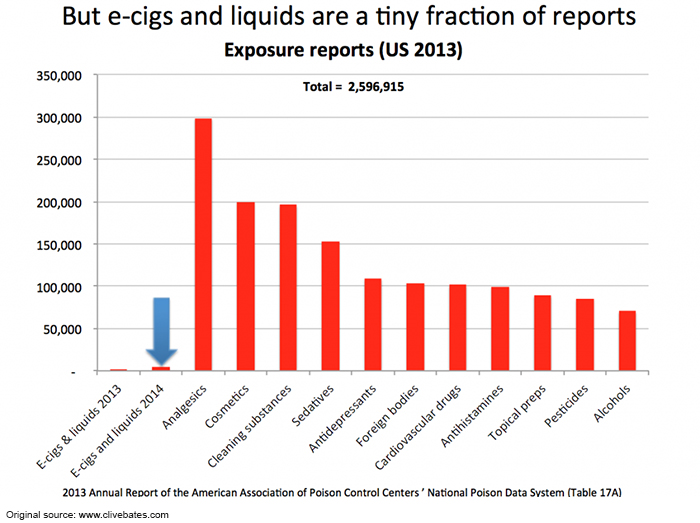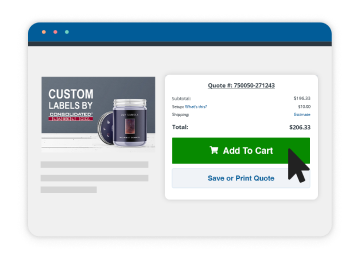
E-cigarettes and vaporizers first hit the U.S. market in 2007 but it has only been in the last couple years that the Food and Drug Administration (FDA) has been getting involved in regulating the vaping industry. As “vaping” grows in popularity, more questions are being raised and government and public health organizations are demanding greater oversight on the manufacturing, distribution and sale of e-cigarettes, vaporizers, and e-juices. Find out what regulations are being proposed and what you can do to ensure your e-cig and e-juice labels are meeting the requirements.
U.S. Vaping Trends and Public Worry
According to Wells Fargo Securities analyst Bonnie Herzog, the number of U.S. vape shops has grown to about 8,500 since 2008, and the sale of e-cigs and vape products climbed to $3.5 billion. With the explosion in the number of vape shops, Herzog expects the use of e-cigs and vaporizers in the United States to overtake traditional cigarettes in 10 years. The shops aren’t the only thing growing in numbers – the number of teens who vape is rising as well. According to a CDC study, more than 13.4% of high school students reported that they have used e-cigarettes in the past 30 days.
The rise in teen use is worrisome for the FDA, CDC, and other health organizations, but it’s not the only reason why these groups are pushing for more regulations. Government regulators and anti-tobacco advocates claim that there hasn’t been enough research on the long-term effects of vaping which is why it needs to be more closely monitored. However, vape businesses and experts in tobacco control credit e-cigs as being the best hope for helping addicted smokers successfully quit. The FDA currently doesn’t regulate e-cigs, vaporizers and e-juices (unless it’s being marketed for therapeutic purposes), but it looks like that may soon change.
Possible Regulations for Vaping Businesses
In 2009, the Family Smoking Prevention and Tobacco Control Act was passed which enabled the FDA to regulate certain tobacco products, including cigarettes and smokeless tobacco. Fast forward to 2014, the FDA’s Center for Tobacco Products proposed a new rule that would allow it to regulate “newly deemed” tobacco products like e-cigs. Proposed regulations for e-cigs and vape manufacturers would be the same that cigarette manufacturers face, requiring them to add health warnings, disclose ingredients, stop sales to minors, and stop giving free samples.
According to the FDA’s website:
Once the proposed rule becomes final, FDA will be able to use powerful regulatory tools, such as age restrictions and rigorous scientific review of new tobacco products and claims to reduce tobacco-related disease and death.
Even as federal regulations are debated, 41 states have banned sales to minors but have different requirements on what should be on warning labels. This can make compliance confusing for e-cig and vape businesses (e.g. Hawaii recently raised the smoking age to 21).
The American Vaping Association (AVA) claims that the FDA’s proposed regulations are more of a “public relations strategy” since the vast majority of e-juice manufacturers already use child-resistant packaging and it’s currently required by fourteen states. The AVA also points out that e-cigs, e-juices and vape products represent a fraction of exposure calls to the U.S. Poison Control Centers.

With so much information floating around on e-cigs and e-juices, figuring out how to package and label vape products can be an overwhelming process. That’s why we’ve compiled some labeling tips to help you create or update packaging labels that provide relevant information to consumers and better protect your business.
Labeling Tips for E-Cig and E-Juice Packaging
We’ve printed many types of labels that must meet FDA requirements such as food, beverage, pharmaceutical, health and medical. Printing FDA compliant labels for e-cigs and e-juices is similar when it comes to ensuring that the labels are legible and adhere through the life of the product. But what about what goes ON the label? Here are some ways you can get smart with your custom labels without sacrificing packaging appeal.
- Include standard warnings to be safe: There are some standard warnings you can include on your e-cig and e-juice labels so consumers are better informed about your product and your business is protected. Here are some warnings that are typically on product labels:
- Must be 18 or legal smoking age to purchase and use.
- Keep out of reach of children and pets.
- May contain nicotine, known to be a highly addictive substance.
- Never drink or ingest.
- Toxic if swallowed or has contact with skin.
- Use bright warning signals to enforce your message: Graphics like an exclamation point, “18+” or skull and cross bones can make it easier to draw consumers’ attention to the warning statements and directions. Although warning signals aren’t (yet) required, they’re an effective way to get your message across. We suggest you use bright colors like red or yellow that are often used for other types of warning labels.
- Easily switch out information with variable data printing: With digital label presses, we can do “variable data printing” which is great if you ever need to update your ingredients, product warnings or manufacturer information. Variable data printing is when the label design/layout stays the same but there is a section of the label left empty for the variable data to be printed. When your information changes, all you need to do is give us your new spreadsheet or database file so we can print your labels with the most up-to-date information.
- Don’t cram your product information and artwork: It’s important that the artwork doesn’t take up most of the space on the label leaving little room for product information, making the product information unreadable or the label less attractive. We suggest that you get all your information squared away before designing the artwork or leave enough space for the product information in case of future changes. E-juice labels can be pretty small (e.g. 1.25” x 2.5”) which is why we recommend you design the label in the actual size it will print because resizing artwork/text can distort the way it looks.
- Make your product statements easy to read: There are several ways to ensure that your product labels are easy to read: text size, color contrast and spacing. Product statements shouldn’t be so small that a magnifying glass is needed to read it, and the text and background colors should have enough contrast from each other so the product statements jump out at consumers. There should also be enough space between the letters, punctuation marks and words so they don’t overlap and cause confusion.
E-cig and e-juice labels are facing increasing scrutiny these days so it’s important that vape businesses keep up with evolving government regulations. With more attention on labels, it’s also important that they look and function properly through the product’s lifespan. Our dedicated customer service reps would be glad to help you select the right combination of materials to ensure your product labels stick and maintain their quality for a long time. We also offer test proof services and can send sample labels if you need to test label materials before committing to an order.


